November 2020
November 6, 2020
All Things Fall
Posted By: Paul - Fri Nov 06, 2020 -
Comments (3)
Category: Death, Technology, Special Effects
November 5, 2020
Graduated Alone
May 1949: Eva Mae Bradbury was the only member of her graduating class at the public school in Ada, Kansas. The school nevertheless put on a full commencement program for her, attended by 150 people (which was about the entire population of Ada).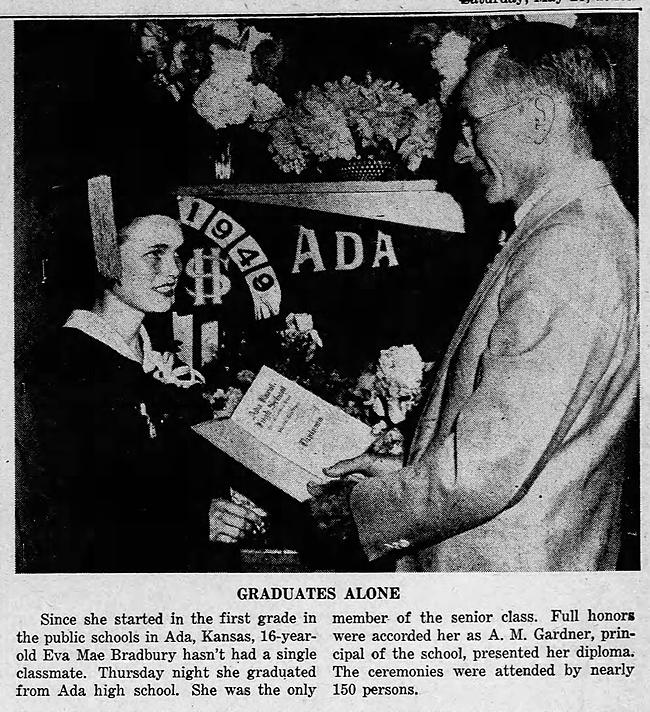
Decatur Herald and Review - May 21, 1949
Posted By: Alex - Thu Nov 05, 2020 -
Comments (2)
Category: School, 1940s
The Spare Tire Cover as Advertising Medium
The earliest surviving instances of this mode of advertising seem to be really rare. If any WU-vie can find more examples, that would be great!Of course, nowadays you can have custom-designed spare tire covers at the drop of a hat!
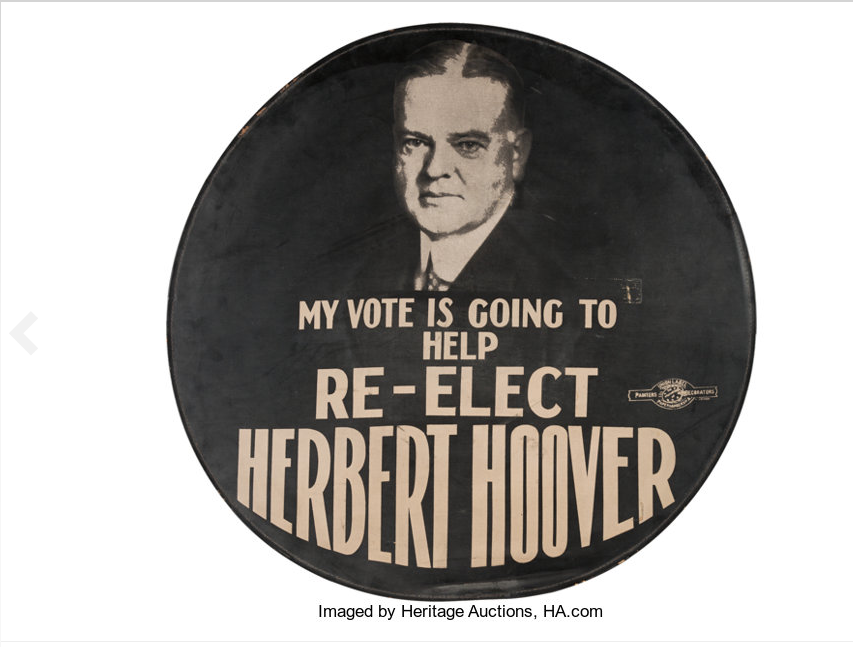
Source.
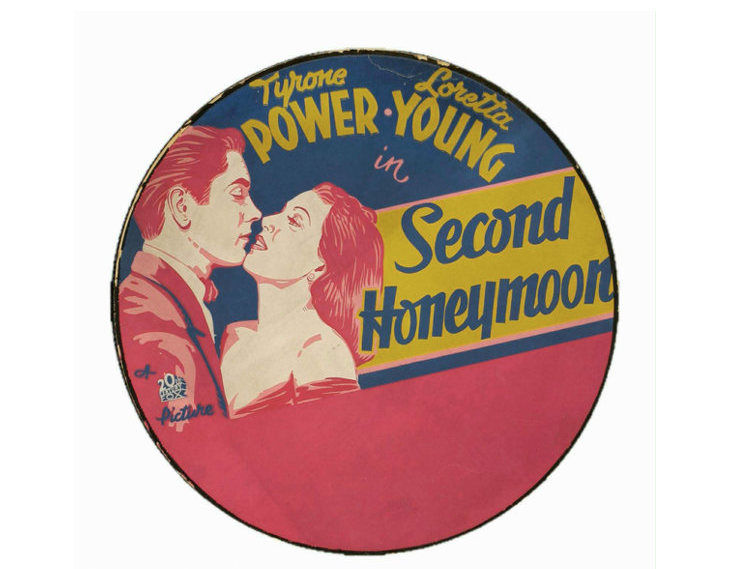
Second Honeymoon (20th Century Fox, 1937). Spare Tire Cover. Throughout the thirties the studios would offer in their pressbooks what were spare tire covers that would advertise their upcoming feature. This silkscreen cover for the Tyrone Power and Loretta Young romance has elastic bands in back which allow it slip right over the tire that was always visible on the back of the automobiles of that time. Probably the theater owner, ushers, or cab companies would be paid to use these. Very interesting novelty that are often seen in pressbooks but few have survived.
Source.
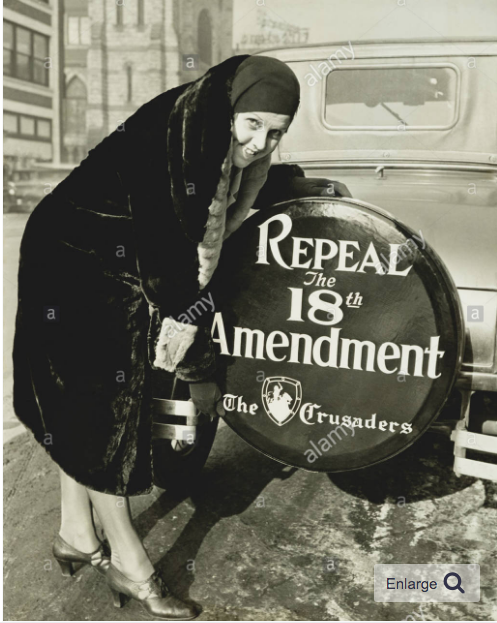
Source.
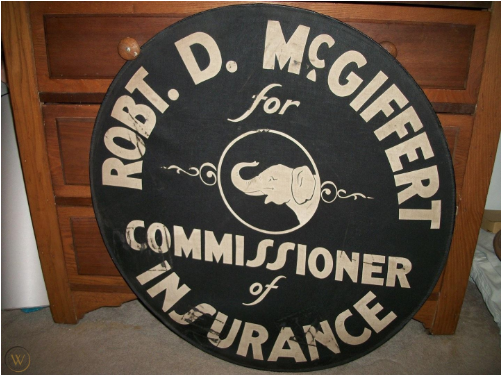
Source.
Posted By: Paul - Thu Nov 05, 2020 -
Comments (3)
Category: Advertising, 1930s, Cars
November 4, 2020
Court refuses one-cent suit
October 1939: The Supreme Court refused to hear the case of C. Leon De Aryan, thereby ending his legal campaign to recover the one cent of sales tax he believed he had been incorrectly charged.Actually, it was worse than that. The actual amount of the excess charge in question was closer to one-half a cent. De Aryan had bought 15 cents worth of cardboard, and had been charged one cent of sales tax on this purchase. He noted that the tax was three percent. Therefore, he should only have been charged approximately one-half cent of tax, but the retailer rounded up.
I'm guessing De Aryan spent a lot more than one cent in court costs.

San Pedro News-Pilot - Oct 9, 1939
This recalls the 1979 case of Frank Makara who felt he had been overcharged $1.95 at the gas station and took his case all the way to the Supreme Court — which then refused to hear it, as it did with De Aryan's case.
Posted By: Alex - Wed Nov 04, 2020 -
Comments (5)
Category: Lawsuits, 1930s
The Tramp’s Unexpected Skate
Posted By: Paul - Wed Nov 04, 2020 -
Comments (0)
Category: Bums, Hobos, Tramps, Beggars, Panhandlers and Other Streetpeople, Juvenile Delinquency, 1900s
November 3, 2020
Rodney Fertel’s Gorilla Campaign
1969: Rodney Fertel ran for mayor of New Orleans on what he called the "primate platform". He promised that, if elected, he would "Get a gorilla for the zoo." This was his primary campaign issue. He campaigned by standing on street corners, sometimes dressed in a safari outfit, sometimes in a gorilla suit, handing out miniature plastic gorillas to passers-by.
Rodney Fertel with a baby gorilla
Fertel lost the election, receiving only 310 votes, but he kept his promise by donating a pair of West African gorillas the following year to New Orleans' Audubon Zoo, at his own expense.
Incidentally, Rodney was the former husband of Ruth Fertel, who founded Ruth's Chris Steak House. Fertel's son has written a book about his parents titled The Gorilla Man and the Empress of Steak: A New Orleans Family Memoir.
More info: nola.com
Posted By: Alex - Tue Nov 03, 2020 -
Comments (3)
Category: Animals, Politics, Strange Candidates, 1960s
The Eskimo HIghkick

High-kick competitions were once part of Kivgiq, the Messenger Feast. As each man entered the qargi he tried to kick an inflated animal bladder or ball suspended from the ceiling. An Iñupiaq story tells of a young woman who owned two balls; the larger was the sun, and the smaller the moon. The sun ball fell (or in one version was dropped by Raven) and burst open, bringing light to the world. The circular designs seen on this ball represent the sun and commemorate this ancient story.
Source of quote (with more pictures).
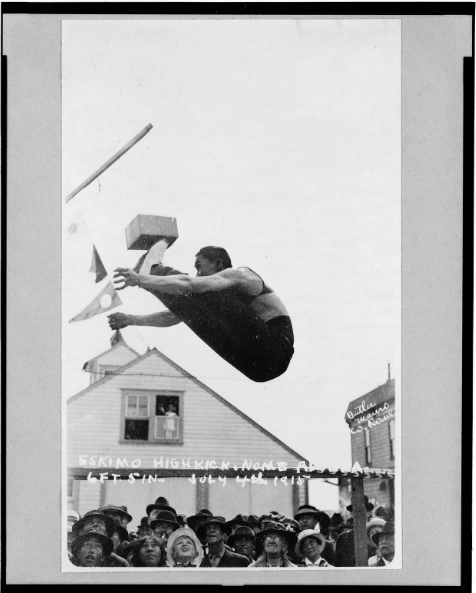
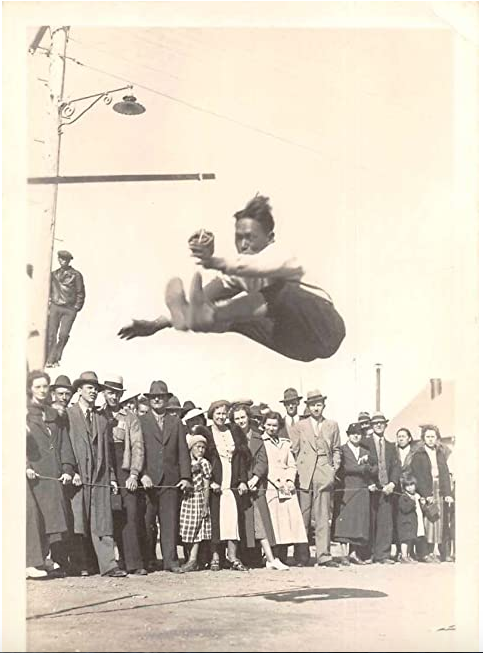
Posted By: Paul - Tue Nov 03, 2020 -
Comments (0)
Category: Ethnic Groupings, Regionalism, Sports
November 2, 2020
250 Times I Saw a Play
Keith Odo Newman, whom the Guardian has described as "a homosexual Austrian psychoanalyst," authored 250 Times I Saw A Play, which was published in 1944. As the title suggests, it describes his experience of watching a play 250 times. The play was Flare Path by Terence Rattigan.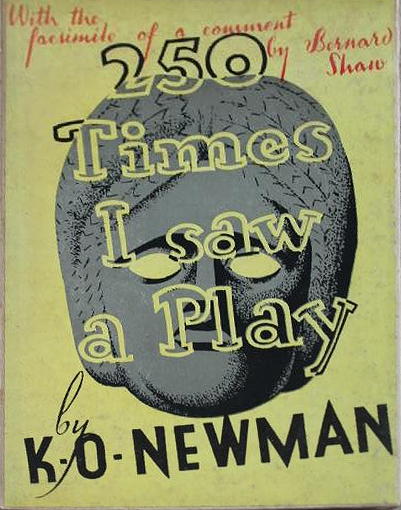
The backstory here is that Newman was Rattigan's doctor. According to TactNYC.org:
For some reason, Rattigan asked Newman to personally direct the performance of the lead actor in the play, Jack Watling, and Newman proceeded to become obsessed with Watling. Which is why, I assume, Newman ended up watching the play 250 times. Rattigan's biographer, Geoffrey Wansell, offers more details:
At this stage Newman had not made a homosexual pass at Watling. That came later. Newman simply frightened him beyond words. 'I couldn't do anything without asking his permission. I was heterosexual then, and I am now, but Newman pretty much gave me a nervous breakdown. I couldn't cope with him.' Why Newman had this power, or why people submitted to him, Watling is just as unable to explain now as he was then.
After completing his odd book, Newman sent the manuscript to George Bernard Shaw, who wrote back with a few of his thoughts about it. Shaw's comments weren't very complimentary, but Newman nevertheless included a facsimile of them at the front of the book. Shaw wrote:
Sure enough, Newman was subsequently certified insane and died in a mental institution.
Posted By: Alex - Mon Nov 02, 2020 -
Comments (1)
Category: Theater and Stage, Books, 1940s
I Took a Trip (On a Gemini Spaceship)
The creator's Wikipedia page.
Posted By: Paul - Mon Nov 02, 2020 -
Comments (2)
Category: Eccentrics, Music, Spaceflight, Astronautics, and Astronomy, Outsider Art, 1960s
November 1, 2020
Landslide—the electoral college board game
Kenneth J. Gross and Sebron Koster were granted a patent in 1960 for Landslide, an electoral college board game. Players moved their pieces around the board trying to gain enough electoral college votes to start a 'landslide'. If you want to play it, the rules are below.As far as I can tell, their game was never sold in stores. However, there have been two other board games called Landslide that did make it to market (in 1971 and 2004). Both involved acquiring electoral college votes but were otherwise different than the 1960 version.
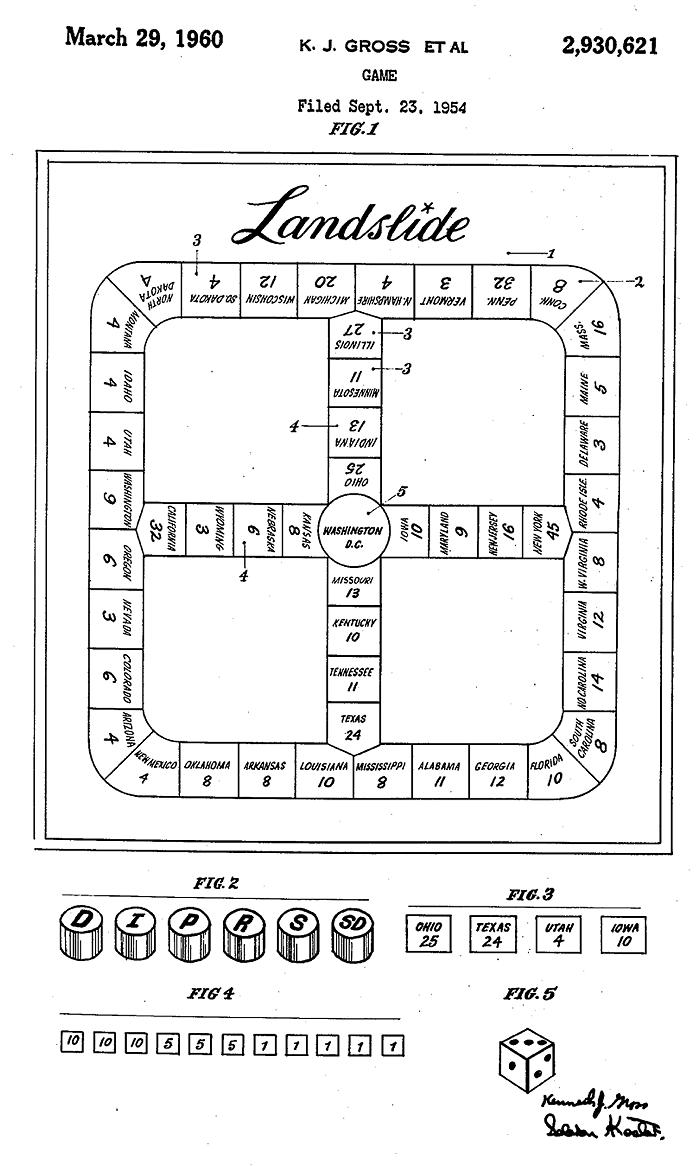
At the start of the play of a game each player selects his political party and takes his marker and tokens to match. Each player or candidate rolls the die and the candidate who rolls high die opens the play. He is succeeded in turn by each candidate in a clockwise direction. All candidates begin their campaign from the central segment, viz. Washington, D.C.
The number appearing on the die indicates the number of segments (States) which the candidate may move his marker and the number of electoral votes he wins in the State attained. He places his marker on that State and beside it his tokens corresponding to the number of votes thereby won in that State.
On each turn a candidate may move in any direction he chooses. The choice of routes allowed to candidates enables them to exert an influence on the development of their campaigns. In passing through a junction of three States he may traverse only two of the States in the course of any one move. He may not reverse his direction of movement in the course of one move. A candidate may not land on nor pass through a State occupied by another candidate's marker. If the movement of a candidate is blocked by the markers of other candidates in such a manner that he cannot move his marker to the full extent of his throw of the die, then he loses that turn. A candidate must move if possible.
A candidate must return to Washington, D.C. at any time that his throw of the die could place him there, providing that Washington, D.C. is unoccupied.
The number of electoral votes of a State won by a candidate is indicated by his tokens placed alongside that State. The entire electoral vote of a State is won by the first candidate to obtain a majority of the electoral votes of that State. When a State is won by a candidate he removes the card of that State and all the electoral vote tokens on that State are returned to their respective candidates.
States that have not been won are indicated by the presence of the State cards still beside them. Any candidate may land on a State that has been won by another candidate irrespective of the presence or absence of electoral votes remaining unacquired.
Whenever a candidate lands on Washington, D.C., he has the right to call a “caucus' if he so desires. When a caucus is declared all candidates count, the electoral votes of the States they have won completely, as indicated by the State cards in their possession. The outstanding electoral votes relating to States not yet won are also counted. Should the candidate with the least number of electoral votes be unable to win the election even by winning all the electoral votes of the States which are not yet won completely then he is eliminated as a presidential candidate. Only one candidate may be eliminated on each caucus.
If on the calling of a caucus, the tally of electoral votes indicates that every candidate still has a chance to win the election assuming his acquisition of all outstanding electoral votes, then the candidate calling the caucus loses all his electoral votes on States not won completely; that is he removes all his electoral vote tokens from the board.
The electoral vote tokens of the eliminated presidential candidate on the States not completely won are removed from the board. The electoral votes of the States completely won by the eliminated candidate are divided among the remaining candidates according to the geographical distribution set out in the table above. In other words the candidate with the most electoral votes from the Eastern States, takes all the Eastern States from the eliminated candidate and similarly for the other geographical groups of States.
The presidential election is won by the first candidate who captures 266 or more electoral votes.
Posted By: Alex - Sun Nov 01, 2020 -
Comments (1)
Category: Games, Politics, Patents, 1960s
| Get WU Posts by Email | |
|---|---|

| Who We Are |
|---|
| Alex Boese Alex is the creator and curator of the Museum of Hoaxes. He's also the author of various weird, non-fiction books such as Elephants on Acid. Paul Di Filippo Paul has been paid to put weird ideas into fictional form for over thirty years, in his career as a noted science fiction writer. He has recently begun blogging on many curious topics with three fellow writers at The Inferior 4+1. Chuck Shepherd Chuck is the purveyor of News of the Weird, the syndicated column which for decades has set the gold-standard for reporting on oddities and the bizarre. Our banner was drawn by the legendary underground cartoonist Rick Altergott. Contact Us |

